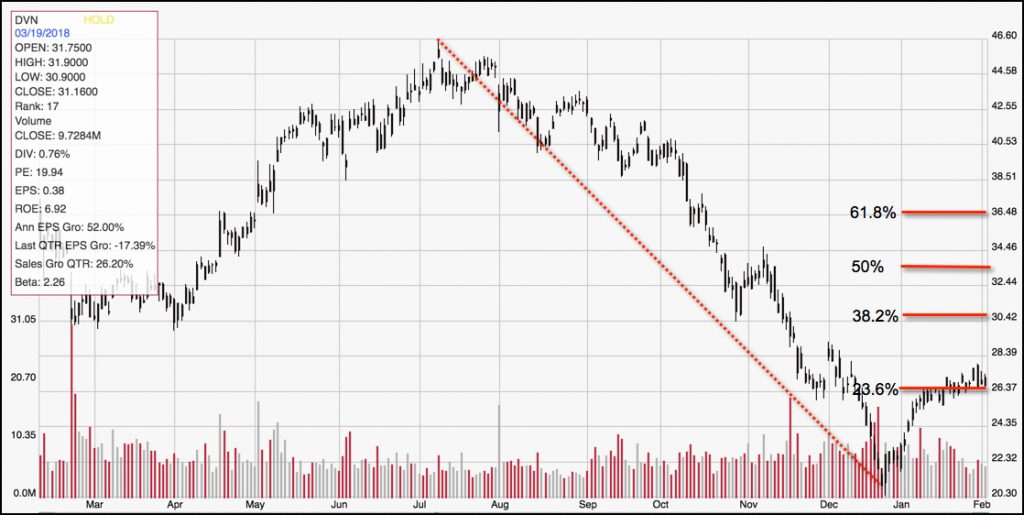The energy sector is one of the most cyclical segments of the market. That’s because so much of the sector is tied, to a greater or lesser extent, to the price of a single commodity: oil. From mid-2014 to the beginning of 2016, oil plunged from about $100 per barrel to as low as $26. Since then, prices have more than doubled, with West Texas Intermediate crude rallying to as high as $74 per barrel in mid-2018 before settling back to its current level in the mid-$50’s. The ebb and flow of those prices often translate to wide variances in the profits of oil companies from quarter to quarter or year to year.
Devon Energy Corp (DVN) is a mid-cap energy company that operates in the oil and natural gas industries. Over the last two years, the stock has fluctuated pretty widely, between highs around $50 and a low in late December around $20 per share. In this last month, however the stock has increased by a little more than 21%, and appears to be picking up bullish momentum. Based on my favorite valuation metric, the stock also carries an impressive bargain proposition. Does that make it a good bet for the market right now?
Fundamental and Value Profile
Devon Energy Corporation is an independent energy company. The Company’s segments include U.S. and Canada. The Company is engaged primarily in the exploration, development and production of oil, natural gas and natural gas liquids (NGLs). The Company’s operations are concentrated in various North American onshore areas in the United States and Canada. The Company’s U.S. and Canada segments are primarily engaged in oil and gas exploration and production activities. The Company’s properties include Barnett Shale, Delaware Basin, Eagle Ford, Heavy Oil, Rockies Oil and STACK. As of December 31, 2016, the Company had three operated rigs. As of December 31, 2016, the Company had approximately 66,000 net acres located in DeWitt and Lavaca counties in south Texas. As of December 31, 2016, the Company’s acreage in the Rockies included approximately 470,000 net surface acres, focused on oil opportunities in the Powder River Basin and the Wind River Basin. DVN has a current market cap of about $12.7 billion.
Earnings and Sales Growth: Over the last twelve months, earnings grew by nearly 37%, while revenue decreased about -18%. In the last quarter, earnings increased even more impressively, by over 85% while sales were up nearly 15%. The company operates with a healthy, and improving margin profile that has been boosted in the last quarter by management’s effort to deleverage by paying off major portions of their debt. Over the last twelve months, Net Income as a percentage of revenues were 14%, and increased more than 98% over the last quarter.
Free Cash Flow: DVN’s free cash flow is marginal, at $237 million. That translates to a mostly unimpressive Free Cash Flow Yield of 2.36%.
Dividend: DVN’s annual divided is $.32 per share, which translates to a yield of about 1.18% at the stock’s current price.
Price/Book Ratio: there are a lot of ways to measure how much a stock should be worth; but one of the simplest methods that I like uses the stock’s Book Value, which for DVN is $19 and translates to a Price/Book ratio of 1.42 at the stock’s current price. The stock’s historical average Price/Book ratio is 2.12, meaning that the stock is more than 32% below its historical Price/Book ratio..
Technical Profile
Here’s a look at the stock’s latest technical chart.

Current Price Action/Trends and Pivots: The diagonal, dotted red line traces the stock’s downward trend from July last year to late December. It also provides the baseline for the Fibonacci retracement lines shown on the right side of the chart. The stock is currently hovering right on the 23.6% line, and appears to be basing strongly at that level. The could be helping the stock build a new set of bullish momentum that could push the stock to the next resistance level around $30.50, shown by the 38.2% retracement line.
Near-term Keys: If you wanted to take an aggressively bullish stance, the stock’s current pattern does appear pretty favorable for a momentum-based trade using call options or buying the stock outright. A break below the stock’s current support at around $27, however could mark a bearish opportunity using put options or shorting the stock, with room for the stock to drop to around $21 at the stock’s 52-week low. The stock’s valuation metrics look attractive, and the company’s balance sheet is improving, which means that the time could be advantageous for a long-term position in the stock right now.